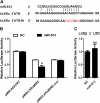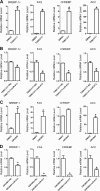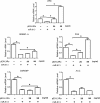MicroRNA-613 represses lipogenesis in HepG2 cells by downregulating LXRα
- PMID: 23496987
- PMCID: PMC3605323
- DOI: 10.1186/1476-511X-12-32
MicroRNA-613 represses lipogenesis in HepG2 cells by downregulating LXRα
Abstract
Background: MicroRNAs (miRNAs) emerge as new important regulators of lipid homeostasis by regulating corresponding genes. MiR-613 is a newly discovered microRNA, of which the biological function is unknown. A recent report has shown that miR-613 downregulates liver X receptor α (LXRα), a ligand-activated nuclear receptor playing an important role in the regulation of lipid metabolism. The purpose of this study is to explore the effect and the molecular basis of miR-613 on lipogenesis in HepG2 cells.
Methods: HepG2 cells were transiently transfected with miR-613 mimic or control microRNA. Real time PCR, Western blot, Luciferase reporter assay and Oil Red O staining were employed to examine the expression of LXRα and its target genes involved in lipogenesis, binding site for miR-613 in 3'-untranslated region (3'-UTR) of LXRα mRNA and lipid droplet accumulation in the cells.
Results: MiR-613 dramatically suppressed the expression of LXRα and its target genes including sterol-regulatory element binding protein 1c (SREBP-1c), fatty acid synthase (FAS), carbohydrate responsive element-binding protein (ChREBP) and acetyl-CoA carboxylase (ACC). Reporter assay showed that miR-613 directly bound to 3'-UTR of LXRα mRNA. Moreover, miR-613 significantly repressed LXRα-induced lipid droplet accumulation in HepG2 cells. Ectopic expression of LXRα without 3'-UTR markedly attenuated the miR-613-mediated downregulation of LXRα's target genes and LXRα-induced lipid droplet accumulation.
Conclusions: MiR-613 suppresses lipogenesis by directly targeting LXRα in HepG2 cells, suggesting that miR-613 may serve as a novel target for regulating lipid homeostasis.
Figures





Similar articles
-
MicroRNA-1 and microRNA-206 suppress LXRα-induced lipogenesis in hepatocytes.Cell Signal. 2013 Jun;25(6):1429-37. doi: 10.1016/j.cellsig.2013.03.003. Epub 2013 Mar 14. Cell Signal. 2013. PMID: 23499676
-
MicroRNA hsa-miR-613 targets the human LXRα gene and mediates a feedback loop of LXRα autoregulation.Mol Endocrinol. 2011 Apr;25(4):584-96. doi: 10.1210/me.2010-0360. Epub 2011 Feb 10. Mol Endocrinol. 2011. PMID: 21310851 Free PMC article.
-
Ursodeoxycholic acid inhibits liver X receptor α-mediated hepatic lipogenesis via induction of the nuclear corepressor SMILE.J Biol Chem. 2014 Jan 10;289(2):1079-91. doi: 10.1074/jbc.M113.491522. Epub 2013 Nov 21. J Biol Chem. 2014. PMID: 24265317 Free PMC article.
-
Transcriptional control of hepatic lipid metabolism by SREBP and ChREBP.Semin Liver Dis. 2013 Nov;33(4):301-11. doi: 10.1055/s-0033-1358523. Epub 2013 Nov 12. Semin Liver Dis. 2013. PMID: 24222088 Free PMC article. Review.
-
Genetic control of de novo lipogenesis: role in diet-induced obesity.Crit Rev Biochem Mol Biol. 2010 Jun;45(3):199-214. doi: 10.3109/10409231003667500. Crit Rev Biochem Mol Biol. 2010. PMID: 20218765 Free PMC article. Review.
Cited by
-
Cardiovascular and Cerebrovascular Disease Associated microRNAs Are Dysregulated in Placental Tissues Affected with Gestational Hypertension, Preeclampsia and Intrauterine Growth Restriction.PLoS One. 2015 Sep 22;10(9):e0138383. doi: 10.1371/journal.pone.0138383. eCollection 2015. PLoS One. 2015. PMID: 26394310 Free PMC article.
-
miR-29a Promotes Lipid Droplet and Triglyceride Formation in HCV Infection by Inducing Expression of SREBP-1c and CAV1.J Clin Transl Hepatol. 2016 Dec 28;4(4):293-299. doi: 10.14218/JCTH.2016.00046. Epub 2016 Dec 26. J Clin Transl Hepatol. 2016. PMID: 28097097 Free PMC article.
-
The Key Role of microRNAs in Initiation and Progression of Hepatocellular Carcinoma.Front Oncol. 2022 Jul 18;12:950374. doi: 10.3389/fonc.2022.950374. eCollection 2022. Front Oncol. 2022. PMID: 35924150 Free PMC article. Review.
-
PPARγ attenuates hepatic inflammation and oxidative stress of non‑alcoholic steatohepatitis via modulating the miR‑21‑5p/SFRP5 pathway.Mol Med Rep. 2021 Nov;24(5):823. doi: 10.3892/mmr.2021.12463. Epub 2021 Sep 24. Mol Med Rep. 2021. PMID: 34558644 Free PMC article.
-
MicroRNA modulation of lipid metabolism and oxidative stress in cardiometabolic diseases.Free Radic Biol Med. 2013 Sep;64:31-9. doi: 10.1016/j.freeradbiomed.2013.07.014. Epub 2013 Jul 17. Free Radic Biol Med. 2013. PMID: 23871755 Free PMC article. Review.
References
Publication types
MeSH terms
Substances
LinkOut - more resources
Full Text Sources
Other Literature Sources
Molecular Biology Databases
Research Materials
Miscellaneous

